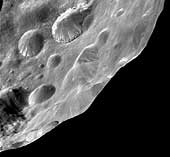|
COMETS EARTH JUPITER KUIPER BELT MARS MERCURY METEORITES NEPTUNE OORT CLOUD PLUTO SATURN SOLAR SYSTEM SPACE SUN URANUS VENUS ORDER PRINTS
PHOTO CATEGORIES SCIENCEVIEWS AMERICAN INDIAN AMPHIBIANS BIRDS BUGS FINE ART FOSSILS THE ISLANDS HISTORICAL PHOTOS MAMMALS OTHER PARKS PLANTS RELIGIOUS REPTILES SCIENCEVIEWS PRINTS
|
Related Documents
Download Options
Phoebe delivers on its promise to reveal new wonders to Cassini by showing probable evidence of an ice-rich body overlain with a thin layer of dark material. The sharply-defined crater at above center exhibits two or more layers of alternating bright and dark material. Imaging scientists on the Cassini mission have hypothesized that the layering might occur during the crater formation, when ejecta thrown out from the crater buries the pre-existing surface that was itself covered by a relatively thin, dark deposit over an icy mantle. The lower thin dark layer on the crater wall appears to define the base of the ejecta blanket. The ejecta blanket itself appears to be mantled by a more recent dark surface lag. This image was obtained on June, 11 2004 at a phase, or Sun-Phoebe-spacecraft, angle of 79 degrees, and from a distance of 13,377 kilometers (8,314 miles). The image scale is approximately 80 meters (263 feet) per pixel. No enhancement was performed on this image. |
